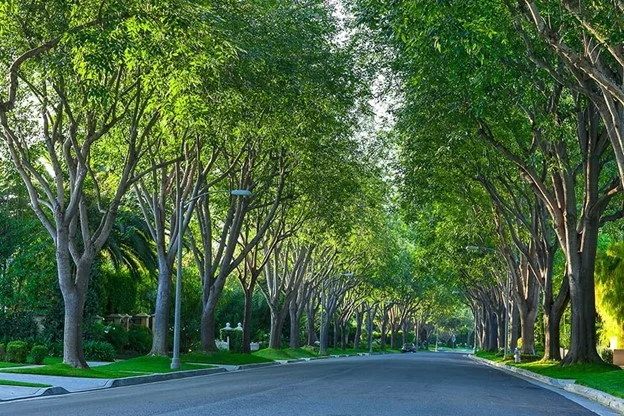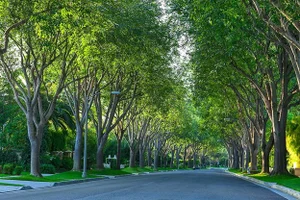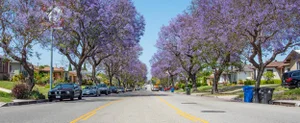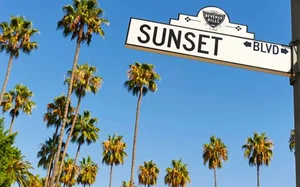
PUTTING DOWN ROOTS

Plans to equitably manage the tree canopy in greater L.A. are finally taking hold.
Having a healthy urban forest is an essential part of a healthy community. If spread equitably, a well-managed canopy cover can deliver healthier soils, biodiversity, habitats, shading from heat and greater community health and well-being. As it stands, L.A. County has about 20% urban canopy cover. That’s OK, but we can do better – both in terms of total coverage and equitable distribution.
The Los Angeles County Chief Sustainability Office (CSO) has made trees a priority in its ambitious OurCounty Plan. The County is now developing an Urban Forest Management Plan – a blueprint that will guide the planting of new trees and the protection of mature trees throughout the region. The CSO will host more 25 workshops later this fall so the public can help shape plans to manage trees in their neighborhoods.
In this Q&A, CSO policy analyst Rebecca Ferdman shares her take on the benefits of trees and how we can work together to help them help us battle climate change.
Let’s start with a general assessment of our tree canopy in Los Angeles. Compared to most major urban areas, do we have a relatively healthy urban forest? Or do we have some work to do?
That depends on where you look, and how you look at it. The first thing to know about our urban tree canopy in L.A. County is that it’s not distributed equally. Some of that is because the County is huge, spanning many different climate zones and ecosystem types. It wouldn’t make sense to have the same goals for tree canopy coverage in a cool coastal area compared to a hot desert area, for example.
However, not all of the variation can be explained that way. The truth is that in L.A. County, low-income communities and communities of color lack access to the benefits of trees due to a history of disinvestment and discriminatory policies. Today, while some places in L.A. have abundant, lush, and healthy canopy cover, many of our marginalized communities lack not only adequate tree canopy coverage, but also sufficient opportunity sites to plant the kinds of large-stature trees that provide the most benefits.
Additionally, we know that the L.A. area experiences hot and dry weather, and that’s only going to increase with climate change. Comparing tree canopy coverage in L.A. to coverage in different rainy climates – places like Seattle or Philadelphia – will never be an apples-to-apples comparison. Instead, I think it’s more helpful to compare L.A.’s tree canopy cover from place to place – is it equitable? And, to compare L.A.’s tree canopy cover over time – is the canopy cover increasing, decreasing, or holding steady? We know our canopy cover is not equitably distributed, and we know that in many places, our canopy cover is actually starting to decrease over time. So, when we think about those questions, we can see that we have a lot of work to do in the County.
Why are trees so important? Both from an ecological point of view and a quality of life point of view?
I think it’s helpful to think of trees as a form of infrastructure, because they provide so many critical services. Front of mind, of course, are the services they provide to combat the climate risk of extreme heat. Tree canopies provide not only shade, but also active cooling – the evapotranspiration from leaves actually cools the surrounding air. Trees can also help reduce air pollution, and they act as carbon sinks. They can also help manage runoff from flooding and extreme precipitation. Trees are also important parts of our local ecosystems, providing habitat and food for all kinds of creatures, including food for humans too.
The list of services trees provide could go on and on – but I think what often gets overlooked are the social benefits that trees provide. They can improve mental health and provide opportunities for social connection and cohesion. They can even serve as traffic calming interventions on busy roadways! So trees are like infrastructure because they provide so many important services to our communities, but they differ from other forms of infrastructure in at least one important way. Most other infrastructure that we invest in, from a bus to a streetlight to a roadway, is at its highest value when it is new, and its value only decreases over time. When you plant a tree, its value actually increases over time. As the tree grows, it continues to increase the magnitude of its impact.

Specifically, what role do trees play in climate change? How can they help us adapt to rising temperatures, wildfires and the like?
The role of trees in preparing our communities for the impacts of climate change is complicated. Trees can provide services that enhance the resilience of our communities, such as shade and cooling to protect against extreme heat. But trees, much like people, are also themselves vulnerable to the impacts of climate hazards. Again, heat is a great example of this – extreme heat can damage or even kill trees that aren’t well equipped to withstand it.
Historically it seems like the more affluent the neighborhood the richer the tree life – even in public areas. That doesn’t seem very equitable. What can we do to make sure that ALL residents benefit from vibrant tree canopies?
It’s clear to see that on average, affluent neighborhoods have higher levels of tree canopy cover than low-income communities. While there are current policies and factors that contribute to that inequity, you’re right to identify historical factors at play. Decades of discriminatory practices and inequitable investments mean that low income areas have more paving – more asphalt and concrete. That means that there are fewer opportunity sites, or places to plant trees – especially large trees. Because of this, increasing canopy cover in low income areas can actually be more expensive and more technically challenging than providing the same amount of coverage in a more privileged area. The costs not only include planting, maintaining, and watering the trees, but also potentially removing pavement – depaving – and making the associated site and infrastructure changes and improvements that are necessary to create new opportunity planting sites for trees. In other words, the places that need trees the most are often the very places where it is most difficult to plant those trees. To overcome this, we will need careful planning, close collaboration with communities, and above all, a commitment to invest the necessary resources.
What kind of trees should we be planting in our communities? What makes the most sense?
Tree species selection is all about “right tree, right place.” We should be planting a diverse palette of trees for a diverse range of situations and benefits. Native trees, like oak trees and sycamores, have tons of benefits – not only are they adapted to our climate and often very drought tolerant, but they are the most important types of trees to plant in terms of biodiversity benefits. But we shouldn’t limit our tree lists to only native trees. There are many trees that are well adapted to our climate that bring other important benefits, such as large shade canopies or low potential for infrastructure conflict. And, there are some trees that have social or cultural importance. For example, many Angelenos love to see our many beautiful jacaranda trees blooming with purple flowers every spring. Fruit trees are also beloved and highly valued by many residents.
Are we talking about planting trees along sidewalks or bigger groves that occupy more space, or both?
I think both, and more. We should be talking about all of our potential opportunities to plant trees, including sidewalks, larger open spaces, public property, private property, and everything in between. However, when it comes to an Urban Forest Management Plan for L.A. County, we’re focusing most of our efforts on the places where the County has most responsibility and control over trees – and that’s street trees and park trees. The County manages an enormous inventory of street trees, including sidewalk and median trees along residential and commercial corridors. These trees can provide cooling, traffic calming, biodiversity, and many other benefits, and nearly every resident of unincorporated County could have the opportunity to interact with or enjoy these trees in some ways. Park trees are equally important, as parks represent our most important opportunities to plant and maintain large stature trees without complications related to infrastructure encroachment.

Along the same path, is the iconic palm tree maybe a thing of the past?
For many Angelenos, the palm tree will always be an icon – and I think that’s great. However, I do think we have room in our hearts for more tree icons. For example, oak trees, such as coast live oaks, are true tree superstars. They are large, long-lived, drought tolerant, and dramatically beautiful – and there is no more important plant host species in our local ecosystems. Let’s make the oak tree a new L.A. icon.
Tell us about the County’s Urban Forest Management Plan. What is driving it and what do you hope to achieve?
The County’s UFMP has been a long time in the works. Stakeholders and County departments identified this action as a priority in the OurCounty sustainability plan. Our office was able to begin work on the UFMP thanks to a grant through the state CALFIRE Urban and Community Forestry grant program. The UFMP is all about helping County departments work together to manage our urban forests through an equity and climate lens, and providing a framework or template that cities in the region can look to as a resource for their own tree management practices.
How can the City of LA and the County work together to achieve mutual goals?
This is one of the things I’m most excited about for the UFMP. Both the County and the City of LA received grants from CALFIRE to create our UFMP, and both of our grants contained funding for stakeholder engagement. Instead of undertaking separate stakeholder engagement processes, the City and County decided to pool our funding and implement a single unified stakeholder engagement plan. This approach has many benefits. It allows us to be more efficient with our funding, so we can actually do more stakeholder engagement together than we could separately. It also allows us to be efficient with our stakeholders’ time – instead of attending a workshop for the County and then a separate workshop for the City, stakeholders can attend a single joint workshop covering both. The joint process also allows us to create and deploy a unified messaging and communications strategy to improve regional consistency and reduce any potential confusion. Finally, it allows the City and the County to lay a foundation of working together around trees, which can carry over past the UFMP planning process and into its implementation.

How can the community be part of the public planning process?
As part of the joint City and County stakeholder engagement process, we will be hosting a series of 50 neighborhood-level workshops, with 25 in unincorporated County communities and 25 in City of L.A. communities. The workshops will be planned and implemented in partnership with local community-based organizations. If you live in unincorporated County or in the City of LA, I encourage you to sign up and participate in a workshop near you. We will be providing engagement opportunities in the months to come on our various social channels.
And what can people do in their homes to help us have more verdant city life, be it trees or plants?
Plant a tree, if you have the space. Choose something you love or that’s meaningful to you, whether that’s a native tree that provides a home for birds and bugs or a fruit tree to feed your family or a tree from another state or country that reminds you of home. Just make sure it’s location and climate appropriate. Or, consider planting native plants in your yard or even on a patio. The best time to plant almost anything in L.A. is the fall, after the hot dry summer and just in time to take advantage of any rain.